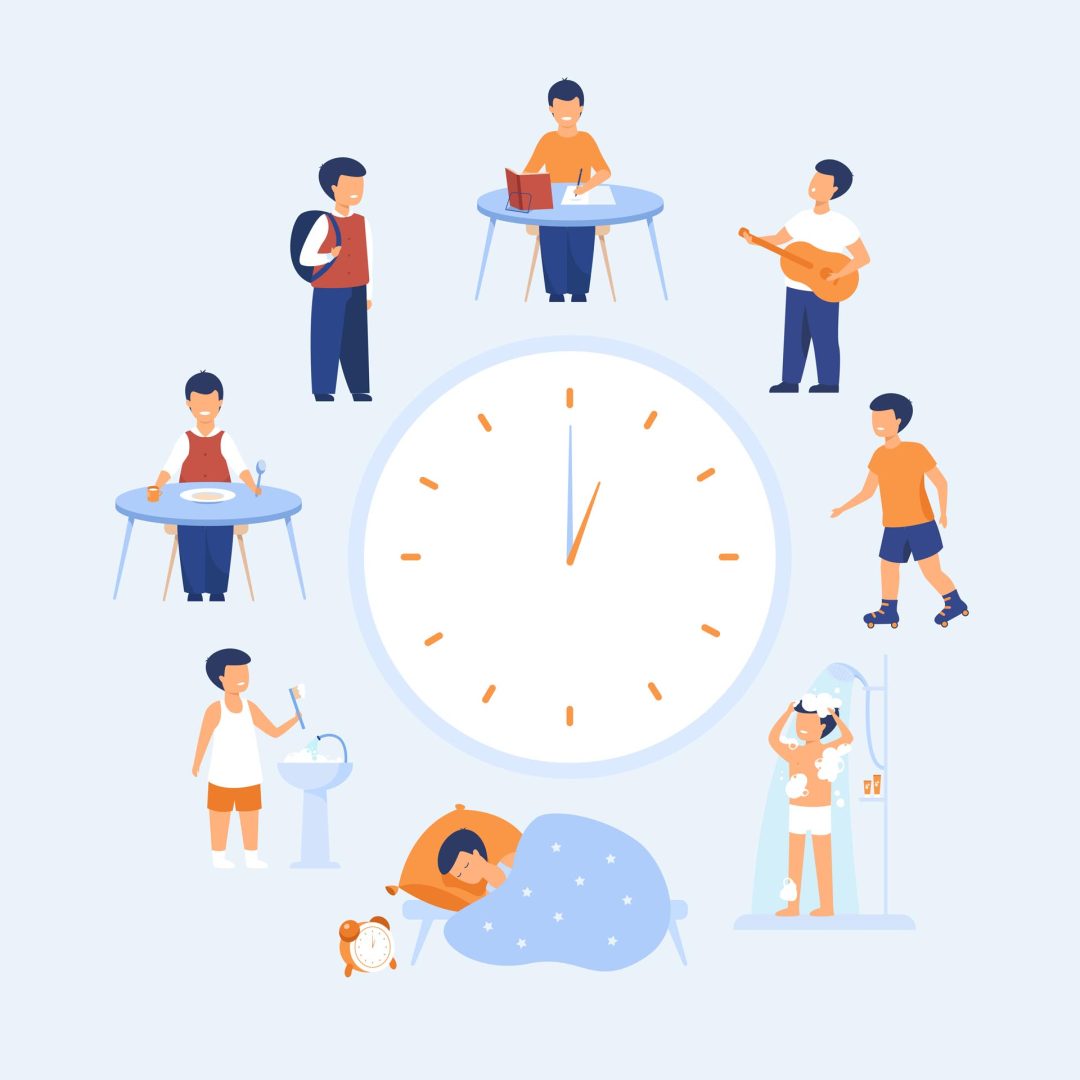Establishing and maintaining routines is crucial for well-functioning families. The following topics will be discussed in detail:
- Routine activities vs daily/weekly schedules
- What makes a family schedule good?
- How to put it together?
- Supplementary rules
- Suggestions on how to support our children in following routines
Let’s start immersing ourselves in the topic by clarifying some concepts that will make it easier for you to read the later content.
According to our perspective, achieving the desired family functioning happens when we operate in an organized manner, creating a predictable structure. This, in turn, leads to reduced stress levels within the family and improved sleep quality, which collectively have a positive impact on children’s behavior.
We achieve organization along predetermined schedules and functioning routines. Let’s explore the relationship between these two terms. The basic meaning of “routine” is “a thorough skill or high proficiency acquired through practice or habituation in a profession or occupation, behavior, or conduct.” Moreover, in everyday language, we often use “routine” to refer to daily scheduling. Upon deeper consideration, the practiced, skilled proficiency and adherence to a schedule align.
However, it’s essential to understand that when establishing and introducing a schedule, achieving routine is more of a goal than an already existing state. Nevertheless, due to its positive connotation or its alignment with the goal-oriented meaning, when discussing family functioning systems, we often prefer using the term “routine” instead of “schedule.”
It’s also crucial to note that many families, even those without strict daily or weekly schedules, have ingrained and consistently maintained routines. At this point, it’s worth considering what our family truly needs. If implementing a tight schedule feels overwhelming or wouldn’t add much value to our lives, or perhaps if our current situation is already functioning well but could benefit from additional regularity, then don’t hesitate! Let’s introduce activities that foster family connections or allocate regular time for relaxation. We can think both small and big. We provide excellent ideas in our articles on the website, but for now, let’s examine the aspects and cornerstones of establishing routines.

How to put together a functional routine?
Based on our research on the topic, we’ve systematically organized activities related to routines according to their nature. You can read about this in detail in our article titled “Charge Up.” When dealing with this topic, always keep in mind that a family routine works effectively when it is well-planned, making the family’s life predictable through its regularity and consistency.
While detailed cornerstone descriptions of specific activities are provided in the respective articles, here are some basic rules on how to approach planning and implementing a schedule.
Planning a Routine
- Define the schedule: Start by determining what schedule works best for your child. Consider their activities, needs, and create a daily and weekly schedule that suits them. Take into account wake-up and bedtime, meal times, playtime, travel time, and any other activities or tasks. Some additional thoughts on this point:
- Plan the routine around the busiest times of the day! Focus on periods before and after work and school on weekdays, and establish fixed times. Everyone should have tasks for the day or activities to occupy themselves with while adults can also attend to their responsibilities.
- Incorporate leisure time into your child’s daily routine! This allows them time to rest, play, or engage in activities they enjoy. Encourage your child to choose leisure activities they enjoy, such as reading, drawing, or playing.
- Connect activities! This can help overcome tedious tasks and serve as reminders. For example, take out the trash when going to the gym, or bring the laundry from your room to the bathroom when taking an evening shower, etc.
- Limit screen time! You can find great ideas for this in these articles.
- Create a “communication” plan: Once the schedule is in place, create a plan for “execution.” Consider how you will discuss the schedule with your child, what tools you will use to track the schedule, and how you will handle changes to the schedule.
- Involve the child in planning: By involving your child in planning the routine, they will feel ownership over it and will be more likely to stick to it. Depending on their age, children can be involved in different aspects of creating their own schedule, but of course, you can discuss points that affect the entire family with the whole family together. Explain to them why the routine is important and discuss how much free time they will have alongside the fixed schedule.
- Family involvement: Planning family routines is primarily the responsibility of adults, but you can brainstorm together with the children. This can include chores, family dinners, and weekend family activities. Ensure that only things that are manageable in terms of finances and other resources are fixed in the daily/weekly/monthly schedule. You can find more ideas related to family activities in articles on the website.
Introducing the Routine
- Support independence: Teach your child to perform activities independently by breaking tasks down into smaller steps. Like in any successful learning process, understanding individual steps and details is crucial, followed by practice and internalization of the activities. Once the child is confident in performing smaller routine tasks, they can be integrated into larger ones. This learning process is applicable when dealing with new, unfamiliar tasks or if you notice a regression in previously mastered tasks. This can happen to any child, so don’t worry if you need to restart the practice.
- Remain consistent: Consistency is key to adhering to the schedule. If someone deviates from the plan, gently guide them back to the agreements, gradually helping them learn the rules and details. Initially, closer attention provides security for the children until they learn the routine.
- Be flexible when necessary: While consistency is important, the schedule shouldn’t be rigidly set in stone! There will be times when it needs to be adjusted, not just if a fixed event, such as a tutoring session, needs to be rescheduled, but also if something simply doesn’t work out as planned in real life. It’s perfectly fine to make changes, but agree on a new schedule and then follow this new routine!
- Be patient: It may take some time for everyone to adjust to the new schedule, especially if they were previously following a more flexible one. Allow them time to adapt. Encourage them when they do well and support them when they encounter difficulties!
Operating the Routine
- Celebrate successes: Whether it’s going to bed on time, completing tasks, or arriving promptly for breakfast, acknowledge your child’s efforts and express how proud you are of them. Positive reinforcement is the strongest motivation for progress, encouraging your child to stick to the established routine! You can find excellent articles related to this topic here.

- Involve the child: Just like in planning, involve your child in making decisions along the way if something doesn’t work out as planned and changes are necessary. Remember! By making decisions together, the child will feel much more ownership over the change and will stay motivated to follow the schedule.
- Use reminders
- Create a visual reminder together! You can use a large cardboard, corkboard, or magnetic board with activities listed in a calendar-like format. You can add colorful pictures, printed icons to help the child follow the schedule. Place the schedule in a visible place, either in a frequently visited area of the house or in the child’s room. The goal is to make the schedule trackable for both the child and the adult.
- Utilize reminder apps: If you’re comfortable with it, there are great apps available for tracking routines.
- Provide support and motivation: Any of the above methods alone might not be enough for children to consistently follow their own routine. They will need support from adults, sometimes verbal reminders if they lose track, or motivation to keep going. Lastly, don’t forget to reward them when they succeed.
- Set achievable goals: Define small, easily achievable goals for your child. This sets the direction for progress, which can build the entire routine adherence. For example, they must finish their homework before dinner or read for 30 minutes before bedtime. These may seem trivial, but small achievements motivate them to stick to the schedule.
Remember! Introducing new behaviors and routines takes time and patience. With consistency and positive reinforcement, your child will learn to adhere to routines persistently, acquiring an important lifelong skill.
If you’d like to read more articles related to this topic, you can click here!


